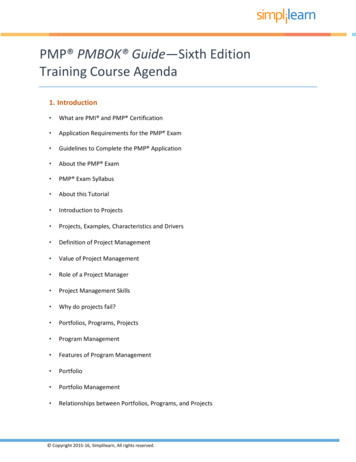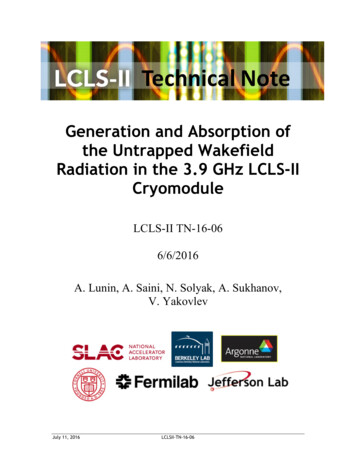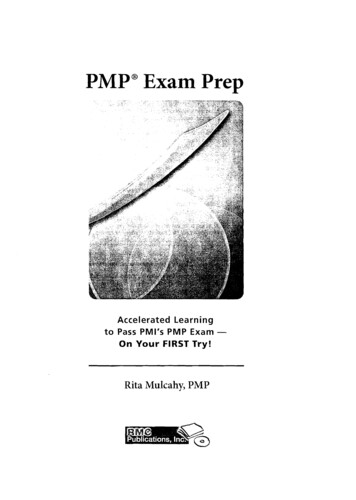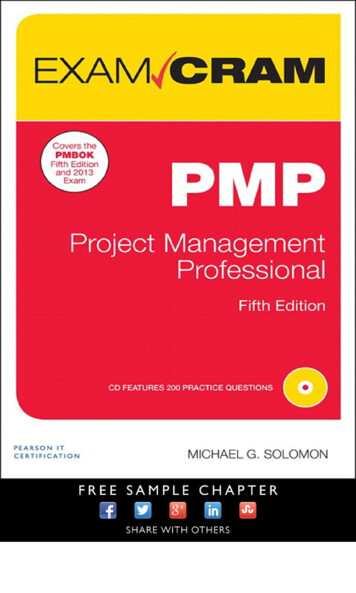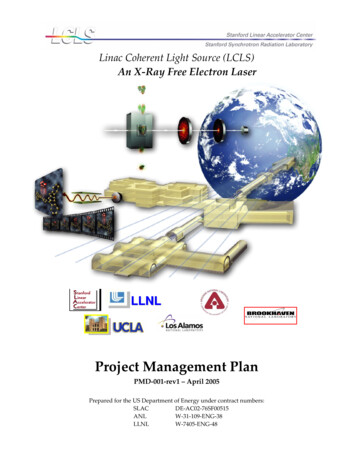
Transcription
Linac Coherent Light Source (LCLS)An X‐Ray Free Electron LaserLLNLProject Management PlanPMD‐001‐rev1 – April 2005Prepared for the US Department of Energy under contract �ENG‐38LLNLW‐7405‐ENG‐48
Submission and ApprovalThis Project Management Plan (PMP) defines the plans, organization and systemsfor managing the Linac Coherent Light Source (LCLS) Project at the Stanford LinearAccelerator Center (SLAC). The LCLS PMP is in accordance with the Departmentof Energy (DOE) M 413.3‐1, Project Management for the Acquisition of Capital Assets,and subject to the requirements specified for projects with a Total Project Cost(TPC) of less than 400 million.Department of EnergyStanford Linear Accelerator CenterNancy SanchezDirector,Stanford Site OfficeJonathan DorfanDirector,Stanford Linear Accelerator CenterHanley LeeLCLS Federal Project Director,Stanford Site OfficeJohn GalaydaLCLS Project Director,Stanford Linear Accelerator CenterArgonne National LaboratoryLawrence Livermore NationalLaboratoryRobert RosnerDirector,Argonne National LaboratoryMichael AnastasioDirector,Lawrence Livermore NationalLaboratory
Table of ContentsAppendicesivList of AcronymsvSection I – Introduction1Purpose of this Project Management PlanParticipants/ContractsOther Important DocumentsSection II – Objectives1357Technical Objectives for the LCLS7Project Schedule Objectives7Project Cost Objectives7Section III – Management Organization and ResponsibilitiesDepartment of Energy99SLAC, ANL and LLNL Project Management, and Advisory Committees11LCLS Management13Section IV – Work Plan23Work Breakdown StructureWork ExecutionSection V – Cost and Labor Estimates232527Cost Estimates27Labor Estimates27Section VI – Funding and Cost Management28Funding Management28Cost Management28Section VII – Configuration ManagementConfiguration Control Board3030Section VIII – Risk and Contingency ManagementRisk ManagementContingency ManagementSection IX – Project Management Control System33333335Section X – Supporting Functions37Section XI – Information and Reporting38Documents and Reports Prepared by DOE38Project Meetings and Reviews38Meetings and Reviews with DOE38Additional LCLS Project Meetings39Section XII – Project Management Plan Review and Modifications42
AppendicesAppendix ALCLS Summary ScheduleAppendix BLCLS L1, L2 and L3 MilestonesAppendix CLCLS Cost Estimate and Funding ProfileAppendix DDOE Office of Science / Lab / LCLS RelationshipAppendix ELCLS Partner Lab Organization and Advisory FunctionAppendix FLCLS Division Organization @ SLACAppendix GTechnical Addendum to the SLAC‐ANL/LLNL MOUAppendix HLCLS Organizational ChartAppendix ILCLS WBS and WBS Dictionary (@ L2)Appendix JLCLS FTE Estimate (by Laboratory)Appendix KBaseline Change Request (BCR) Thresholds
List of WBSActual Cost of Work PerformedAcquisition ExecutiveArgonne National LaboratoryActual YearBaseline Cost EstimateBaseline Change RequestBudgeted Cost of Work PerformedBudgeted Cost of Work ScheduledDOE Basic Energy SciencesCost Performance ReportDepartment of Energy Acquisition RegulationsU.S. Department Of EnergyEstimate at CompletionEnvironment, Safety, and HealthEnergy Systems Acquisition Advisory BoardFacilities Advisory CommitteeFederal Acquisition RegulationsInter‐Laboratory Coordinating CommitteeIntegrated Safety Management SystemIntegrated Project ScheduleLinac Coherent Light SourceLawrence Livermore National LaboratoryManaging and OperatingOther Project CostProject Management Control SystemProject Management PlanQuality AssuranceResearch & DevelopmentRisk Management PlanScientific Advisory CommitteeSelf‐Amplified Spontaneous EmissionStanford Linear Accelerator CenterDOE Stanford Site OfficeTotal Estimated CostTotal Project CostX‐Ray Free Electron LaserWork Breakdown Structure
Section I – IntroductionPurpose of this Project Management PlanThis Project Management Plan (PMP) defines the plans, organization,responsibilities and systems for managing the Linac Coherent Light SourceProject (hereafter referred to as LCLS) to be constructed at the Stanford LinearAccelerator Center (SLAC). The PMP is a field‐level plan documentingagreements between the Department of Energy (DOE) Stanford Site Office andSLAC on the execution of the LCLS project. The PMP supplements the DOEProject Execution Plan.Additional information on the LCLS may be found se and Scope of the LCLS ProjectThe primary purpose of the LCLS Project is to create a world class researchfacility delivering coherent laser radiation in the x‐ray region of the spectrum tenbillion times greater in peak power and peak brightness than any existing x‐raylight source. Utilizing the principles of Self‐Amplified Spontaneous Emission(SASE), the LCLS will provide the world’s first demonstration of an x‐ray free‐electron‐laser (XFEL), operating in the 1.5–15 Angstrom (Å) range and utilize theextraordinary, high‐brightness x‐ray pulses as a powerful tool for researchspanning such areas in the physical and life sciences as: Atomic physics Plasma physics Structural studies on single particles and bio‐molecules Femtosecond chemistry Studies of nanoscale dynamics in condensed matter physics X‐ray laser physicsGiven the short duration of the LCLS pulse (230 femtosecond and shorter), theLCLS will provide an opportunity to observe the ultra‐fast processes of atomictransition, chemical bond formation and breaking, and transitions in condensedmatter structures. With a sufficiently short pulse the LCLS can, in effect, function1
as a stroboscopic flash for freeze‐frame photography of atomic, molecular andnanoscale structures as they evolve.The LCLS will be located within the SLAC complex as shown below:Linac Coherent Light Source at SLACSLAC LinacLCLSInjectoE-BeamTransporFarExperimentHall (underground)UndulatoNear Experiment HallThe Linac Coherent Light Source (LCLS) at SLACThe specific goal for the LCLS project is to produce a coherent x‐ray pulse with a0.15 nm wavelength and a subpicosecond pulse length. In order to achieve thisgoal, the project proposes to build an XFEL Facility on the SLAC site. This willrequire a new 135 MeV injector constructed at Sector 20 of the 30‐sector SLACLinac to create the high brightness electron beam required for the XFEL. The lastone‐third of the linac will be modified by adding two magnetic bunchcompressors. Most of the linac, and its infrastructure, will not be changed. Theexisting components in the Final Focus Test Beam tunnel will be removed andreplaced by a transfer line across the SLAC Research Yard. An undulator tunnelpassing through the berm east of the research yard will house a 120‐meter2
undulator and associated equipment. Two experimental halls will be constructed.A Near Hall will be constructed approximately forty meters downstream of theundulator and a Far Hall will be constructed approximately two hundred fiftymeters downstream of the Near Hall. Provisions will be made for x‐rayendstation enclosures, as well as instrumentation and controls for identifying andcharacterizing the x‐ray beam. A Central Laboratory and Office (CLO) buildingwill be constructed to facilitate the operations and research of the LCLS program.The SLAC site has been selected for the LCLS because it makes use of the lastkilometer of the SLAC linac as a source of a high‐quality electron beam for theLCLS FEL. In addition, the experienced SLAC support staff and existinginfrastructure provide the optimum location for LCLS construction andoperations.The LCLS operational plan calls for a simultaneous use of the Linac by the PEP‐IIHigh‐Energy Physics Experimental Program. At least 75% of the annualoperating schedule for the last third of the SLAC linac will be dedicated to theLCLS. The remaining 25% of operation time may be scheduled for test beams andfixed‐target experiments requiring up to 50 GeV beams. LCLS has been designedto switch from LCLS operations to 50 GeV operations in 24 hours. For injection,LCLS has no impact on PEP‐II.Participants/ContractsThe LCLS Collaboration consists of a team of scientists and engineers from theBrookhaven National Laboratory (BNL), Argonne National Laboratory (ANL),Los Alamos National Laboratory (LANL), Lawrence Livermore NationalLaboratory (LLNL), SLAC and the University of California at Los Angeles(UCLA).During the design and construction phase, the LCLS project is organized as athree‐laboratory partnership, led by SLAC in collaboration with ANL and LLNL.This partnership allows each laboratory to bring their unique technical strengths:SLAC – accelerators; ANL – undulators; and LLNL – x‐ray beam transfer optics tothe LCLS project thus reducing the need to duplicate core competencies andsupport staff. SLAC, as the Host Laboratory for the LCLS, will use existingpersonnel and proven systems and procedures to manage the project.3
The LCLS project is sponsored by the DOE Office of Science. Work for the LCLSwill be performed under the following DOE �109‐ENG‐38W‐7405‐ENG‐48Overall DOE management responsibilities for the LCLS are detailed in the ProjectExecution Plan for the Linac Coherent Light Source (hereafter referred to as the LCLSPEP). An update to the LCLS PEP will include the construction start‐up phases ofLCLS. In accordance with DOE M 413.3‐1, Project Management for the Acquisition ofCapital Assets, the Director of Office of Science, SC‐1, is the Acquisition Executive(AE) for the LCLS project. The DOE’s Stanford Site Office (SSO) reports to theOffice of Science and administers the Managing and Operating (M&O) contractfor SLAC with Stanford University, which includes the day‐to‐day oversight ofSLAC. The SSO Director delegates responsibility and authority for execution ofthe LCLS project to the LCLS Federal Project Director. A complete description ofthe roles and responsibilities within the LCLS project as they apply to the DOE,SLAC and its partner labs, ANL and LLNL, is described in Section III.4
Other Important DocumentsAcquisition Execution Plan (AEP)The Acquisition Execution Plan (October 2002) has been prepared by the DOEStanford Site Office within the DOE Office of Science. The AEP describes themission need and initial pre‐planning strategies and key decisions for theLCLS project from the DOE perspective.Conceptual Design Report (CDR)The LCLS Conceptual Design Report (April 2002) provides the detailed overallsystems requirements and defines the technical criteria for each of the majorsystems for the project.DOE Project Execution Plan (PEP)The DOE Project Execution Plan for the LCLS has been prepared by the DOEStanford Site Office within the DOEʹs Office of Science. This Project Planincludes a Project Charter and describes LCLS management, organization, androles and responsibilities from the DOE perspective.Environmental Assessment for the LCLS Experimental FacilityThe Environmental Assessment for the LCLS Experimental Facility (December2002) provides an evaluation and summary of potential environmental effectsof the LCLS project on the SLAC site. A finding of No Significant Impact wasissued in February 2003.LCLS Global Requirements DocumentThe LCLS Global Requirements Document specifies the performancerequirements for the LCLS x‐ray free‐electron laser to be constructed at theStanford Linear Accelerator Center (SLAC).Preliminary Hazards Analysis DocumentA Preliminary Hazards Analysis Document was completed by SLAC andapproved by DOE/SSO in June 2002. This document provides an earlyevaluation of potential hazards that may impact the construction phase of theLCLS.5
Risk Assessment and Management PlanA Risk Assessment and Management Plan identifies and quantifies key risksto the LCLS project. This document provides early assessment of potentialrisks to the LCLS project and formulates strategies to address the risks.Copies of all documents can be obtained in the LCLS Project Office. AdditionalInformation on the LCLS project and its scientific program can be found on theLCLS website at http://www‐ssrl.slac.stanford.edu/lcls.6
Section II – ObjectivesThe primary objective of the LCLS project is to construct the worldʹs first x‐rayfree electron laser (XFEL) that will serve as a facility for the application of XFELradiation to experimental science and a research and development center forXFEL physics in the hard x‐ray regime. This objective will be accomplishedwithin the cost and schedule requirements accepted by the DOE and the LCLSProject.Technical Objectives for the LCLSThe primary technical objective of the LCLS is to provide coherent radiation ofextraordinary brightness with greater than 1011 photons per pulse in a 0.2%‐0.4%energy bandpass with a pulse duration of 230 femtosecond or less. The LCLSfacility will include two experimental halls, with associated office and laboratoryspace, where the x‐ray beam will be utilized for research in physics, chemistryand biology. The Key Design Operating Parameters List for the LCLS are definedin the LCLS Global Requirement Document (GRD 1.1‐001), which can be found onthe LCLS website.Project Schedule ObjectivesThe LCLS project formally began in Fiscal Year (FY) 2002 with DOE funding forResearch & Development activities. Project Engineering and Design (PED) fundswere available in FY2003 with completion of PED scheduled for the third quarterof FY2008. LCLS construction is planned to begin in the third quarter of FY2006to be followed by a staggered commissioning phase. LCLS operations arescheduled to begin in the third quarter of 2009. The LCLS Project Level 1, Level 2and Level 3 milestones, which form the basis of the LCLS schedule baseline, areprovided in Appendix B.Project Cost ObjectivesThe Total Estimated Cost (TEC) for the LCLS project is 315.0 Million Actual‐Year(AY) dollars and the Total Project Cost (TPC) is 379.0 Million Actual‐Year dollars.7
The LCLS TEC and TPC spending profiles, along with projections of DOEfunding are shown in Appendix C.8
Section III – Management Organization and ResponsibilitiesDepartment of EnergyThe roles, responsibilities, and authorities of the U.S. DOE Office of Scienceparticipants are described below. Appendix D depicts the relationships betweenthe DOE and the partner laboratories as they apply to the LCLS project.Office of ScienceThe Director of the Office of Science (SC‐1) is the Program Secretarial OfficerAcquisition Executive (AE) for the LCLS project. As such, SC‐1 has fullresponsibility for project planning and execution, and for establishing broadpolicies and requirements for achieving project goals. Specific responsibilitiesfor the LCLS project include: Chair the ESAAB Equivalent Board.Approve Critical Decisions and Level 1 baseline changes.Approve the Project Execution Plan.Delegate approval authority for Level 2 baseline changes to the FederalProject Director.Conduct Quarterly Project Reviews.Ensure independent project reviews are conducted.Office of Basic Energy SciencesUnder the Energy Policy Act of 1992, SC’s Director for Basic Energy Sciences(SC‐22) is responsible for planning, constructing, and operating user facilitiesto provide special scientific and research capabilities to serve the needs of U.S.universities, industry, and private and Federal laboratories. Within BES, theScientific User Facilities Division (SC‐22.3) has direct responsibility forproviding funding, and programmatic guidance to the LCLS project. TheLCLS Program Manager, in SC‐22.3, is the primary point of contact with thefollowing responsibilities: Oversees development of project definition, scope and budget.9
Prepares, defends, and provides project budget with support from thefield organizations.Reviews and provides recommendations to the AE on Level 0 and 1baseline changes.Monitors Level 1 and 2 technical, cost, and schedule milestones.Participates in Quarterly Reviews, ESAAB Equivalent Board meetings,and project reviews.Ensures ES&H requirements are implemented by the project.Coordinates with other SC Staff offices, HQ program offices and theOECM.DOE Stanford Site Office (SSO)The SSO reports to the Office of Science and administers the M&O contract forSLAC with Stanford University, which includes day‐to‐day oversight ofSLAC. The SSO Director delegates responsibility and authority for executionof the LCLS project to the LCLS Federal Project Director whose specificresponsibilities include: Day‐to‐day oversight of the project and provides direction to ensure itstimely execution.Monitors, reviews, evaluates, and reports on the performance of theproject against established technical, cost, and schedule performancebaselines.Ensures environment, safety and health (ES&H) is integrated into theproject.Leads the Integrated Project Team.Approves Level 2 change control proposals as delegated by the AE.Review and provide recommendations to the AE for Level 0 and 1change control proposals.Authorizes use of project contingency in accordance with the levelsdescribed in this PEP.Participates in Quarterly Project Reviews, ESAAB Equivalent Boardmeetings, and project reviews conducted by the LCLS project and DOEHQ.Conducts management meetings to monitor and review status ofproject activities.Maintains project data in the DOE Project Assessment and ReportingSystem (PARS).10
Issues Project Directive Authorizations for disbursement of funds andwork authorizations.Prepares project documents such as the Project Execution Plan,Acquisition Strategy (formerly the Acquisition Execution Plan) andProject Quarterly Reports.Coordinates matrix support from the SC Integrated Support Centers.Prepares and submits budget and funding documents to the BESprogram manager. (e.g. Congressional Project Data Sheet)SLAC, ANL and LLNL Project Management, and Advisory CommitteesAppendix E provides an organizational chart illustrating the relationships (for thepurposes of this project) between SLAC, ANL and LLNL laboratory management;LCLS Project Management; and various advisory committees. An explanation ofthe responsibilities of key managers, are provided below:SLAC DirectorThe SLAC Director has the ultimate responsibility for designing andconstructing the LCLS Project in keeping with the requirements of the SLACDOE contract DE‐AC02‐76SF00515. The Director has delegated the authorityto manage and execute the LCLS project to the LCLS Project Director, and willensure that the LCLS Project Director has priority access to all of SLAC’sresources for that purpose.The SLAC Director has established a separate LCLS Division during the PEDand construction phase of the LCLS project. This reorganization creates aseparate LCLS Division and establishes the LCLS Project Director as anAssociate Director of SLAC reporting directly to the SLAC Director. (SeeAppendix F for additional details.) Key personnel for the LCLS Project willreport to the LCLS Division establishing a direct line managementorganization to support the activities of the LCLS project. Other personnelwill be matrixed from other SLAC divisions to provide support to the LCLSProject.ANL/LLNL Directors11
The ANL and LLNL Directors ensure that the appropriate resources for theirlaboratories are applied to support the project in keeping with their DOEcontracts. The Directors jointly review with the SLAC Director the findings ofthe Machine Advisory Committee, and initiate adjustments in programdirection as needed.The ANL and LLNL Directors will appointrepresentatives to the Inter‐Laboratory Coordinating Council (ILCC). TheDirectors will ensure that issues raised by the ILCC are addressed in a timelymanner.The ANL Director and LLNL Director have worked with the SLAC Director toapprove Memoranda of Understanding (MOU’s), which describe the terms ofagreement with respect to their laboratories’ participation in the LCLS project.Each year, a Technical Addendum to the MOU is written between SLAC andits partner laboratories to define the annual scope of work, resources andschedule requirements for the LCLS. An example of the Technical Addendumbetween SLAC and ANL/LLNL is shown in Appendix G.Facilities Advisory CommitteeThe Facilities Advisory Committee (FAC) is a standing committee appointedby the LCLS Project Director, with concurrence from the SLAC, ANL andLLNL Directors, to provide advice on the progress of LCLS construction.Members of this group will be selected from the international scientificcommunity with expertise in the project areas of interest. The FAC not onlyadvises the three laboratory Directors, but has a primary role in providingguidance and feedback to the Project Director and his management team. TheFAC meets and publishes a status report on the LCLS project biannually.Scientific Advisory CommitteeThe Scientific Advisory Committee (SAC) is a standing committee appointedby the LCLS Project Director, with concurrence from the SLAC, ANL andLLNL Directors, to provide guidance on the LCLS scientific research program.Members of this group will be selected from throughout the scientific usercommunity with expertise in atomic, plasma and laser physics, femtosecondchemistry and biology, and nanoscale physics and will provide advice andrecommendations on the initial direction of LCLS programmatic research. TheSAC meets and publishes a status report on the LCLS scientific programbiannually.12
Conventional Facilities Advisory CommitteeThe Conventional Facilities Advisory Committee (CFAC) is a standingcommittee appointed by the LCLS Project Director to provide guidance on theLCLS conventional facilities aspect of the project. The CFAC meets on an asneeded basis depending on the progress of the conventional facilities. Areport is published after meetings.Inter‐Laboratory Coordinating CommitteeThe purpose of the Inter‐Laboratory Coordinating Committee (ILCC) is toaddress issues affecting resource allocation to the LCLS project at the partnerlaboratories, optimization of LCLS Project resources with other laboratoryactivities, and coordination of partner laboratories’ LCLS activities. EachLaboratory Director shall appoint a representative to the ILCC with lineresponsibility for resource allocation to the LCLS Project. The ILCC is chairedby the LCLS Project Director and will meet quarterly or spontaneously shouldan immediate need arise. The Federal Project Director will be invited to attendILCC meetings.LCLS ManagementAppendix H provides an overview of the organization chart for the LCLS Project.The roles and responsibilities of the LCLS Project Management organization aredescribed below:LCLS Project DirectorThe LCLS Project Director reports to the SLAC Director and is responsible forthe direction of LCLS design and construction activities and the research anddevelopment program to support the LCLS, including coordination of SLAC,ANL, and LLNL personnel assigned to the project. The LCLS Project Directoris responsible for approving the selection of staff for the design, construction,commissioning, and initial operation of the LCLS facility.Specificresponsibilities include: Day‐to‐day management and overall direction of the LCLS project.13
Ensuring that ES&H responsibilities and requirements are integratedinto the project, providing an Integrated Safety Management System(ISMS) for the LCLS.Establishing technical and administrative controls to ensure project isexecuted within approved cost, schedule and technical scope.Directing and coordinating supporting R&D and commissioningactivities with construction activitiesRepresenting the project in interactions with the DOE and otherlaboratories. Participating in management meetings with DOE andcommunicates project status and issues.Chairing the Configuration Control BoardChairing the Inter‐Laboratory Coordinating CouncilChairing the Change Control Board.Approving Level 3 change control proposals. Preparing and providingrecommendations to the Federal Project Director for Level 0, 1, and 2change control proposals, as required.Identifying and managing project risks.Member of the Integrated Project Team.LCLS Chief EngineerThe LCLS Chief Engineer reports to the Project Director and has the followingresponsibilities: Carrying out the LCLS Project Director functions when the LCLSProject Director is unavailable. Providing support for all the functions performed by the LCLS ProjectDirector. Facilitating and overseeing interlaboratory coordination. Serving as the Configuration Manager of the Configuration ControlBoard. Coordinating engineering work for the entire project. Directing project planning, scheduling, and budgeting and overseeingthe Project Office and Support function. Defining estimating rules, practices, and procedures and managingperiodic project re‐estimates. Establishing, maintaining, documenting, and enforcing engineeringstandards. Establishing technical definitions of all project procurements.14
Member of Integrated Project Team.System Managers (Electron Beam, Photon Beam and Conventional Facilities)The LCLS Electron‐Beam, Photon‐Beam and Conventional Facilities Managersreport to the LCLS Project Director and have the following responsibilities: Directing and coordinating the integrated effort of their respectiveLCLS WBS systems.o “Electron‐Beam” includes the Injector, Linac, Undulator and GlobalControls WBS systems.o “Photon‐Beam” includes the XTOD, XES and Global Laser WBSsystems. Conducting Preliminary and Final Design Reviews as necessary toensure a high‐quality design that meets the technical performancespecifications of the LCLS. Critical review of project planning, scheduling and cost estimating fortheir LCLS system. Approving all Level 4 change control proposals. Ensuring that all work in their integrated LCLS system is planned andexecuted in accordance with SLAC and LCLS ES&H policy and ISMSprocedures. Serving as members of the Configuration Control Board.The LCLS Project Organization chart indicates the line authorities andresponsibilities of the Electron Beam Systems Manager and the Photon BeamSystems Manager.WBS Managers (Injector, Linac, Undulator, etc.)The LCLS WBS Managers report to their respective LCLS E‐Beam and P‐BeamSystem Managers and have the following responsibilities: Planning and managing the design, construction, installation, andcommissioning of their respective WBS system.Serving as the Cost Account Managers for all cost accounts in theirLCLS system.15
Participating in project planning, scheduling and cost estimating fortheir LCLS system.Approving Level 4 change control proposals.Ensuring that work in their respective LCLS system is planned andexecuted in accordance with SLAC ES&H policy and ISMS proceduresServing as members of the Configuration Control Board.Accelerator Team Leader and Physicist Liaisons (Injector, Linac, Undulator, etc.)The LCLS Accelerator Team Leader, the X‐Ray Endstation Systems LiaisonPhysicist and the X‐Ray Transport/Optics/Diagnostics Liaison Physicist reportto the Project Director.The LCLS Accelerator Team Leader has the following responsibilities: Directing the physics liaisons responsible for the Injector, Linac,Undulator, Conventional Facilities, and Controls.Directing the development and documentation of physics specificationsfor LCLS technical systems.Directing the development of commissioning plans for the LCLSelectron beam systems.Directing the commissioning team and commissioning process for theLCLS electron beam systems to meet the LCLS FEL goals.Coordinating activities listed above with LCLS groups working on x‐ray diagnostics and experiments.The LCLS Accelerator Physics Liaisons report to the LCLS Accelerator TeamLeader as indicated in the LCLS Organization Chart.All Physicist Liaisons have the following responsibilities: Acting as a liaison for their respective LCLS WBS Manager with SLACoperational infrastructure and personnel.Ensuring the physics performance of their respective WBS scope willmeet the operational requirements of the LCLS and the SLAC Linac.Establishing and documenting performance specifications and physicsparameters of their respective LCLS WBS scope.Establishing and documenting specifications for operational andcontrols parameters of their respective LCLS WBS scope.16
Developing commissioning goals and procedures and optimize thephysics performance of the LCLS.LCLS ES&H OfficerThe LCLS ES&H Officer reports to the LCLS Project Director and isresponsible for: Under the direction of the LCLS Project Directorate, and inconformance of SLAC’s Integrated Safety Management System (ISMS),maintaining the LCLS ISMS to ensure a safe working environment forthe LCLS.Providing all levels of LCLS management with advice, information andother resources appropriate to the LCLS project safety oversight.Assisting line management in writing environment, safety, and healthdocuments, or authoring these documents as assigned by the LCLSProject Director.Reviewing proposed designs, procedures, and practices forenvironment, safety, and health considerations.Acting as a liaison for the LCLS Project with the SLAC Environment,Safety, and Health (ES&H) Division and the SLAC Safety OversightCommittee (SOC) to ensure that laboratory‐wide environment, safety,and health policies are followed.Coordinating with the SLAC ES&H Division on training requirementsfor LCLS Project members.Acting as LCLS Project liaison in environment, safety, and health auditsconducted by the DOE or the ES&H Division.Supporting of line managementʹs activities to determine if environment,safety, and health requirements are being followed.Advising LCLS management on progress toward completion ormonitoring of project schedules of environment‐, safety‐, and health‐sensitive milestones.Recommending to the LCLS Project Director corrective action forsituations
Microsoft Word - lcls_pmp_rev13.doc Author: heleno Created Date: 5/4/2005 4:57:56 PM .

